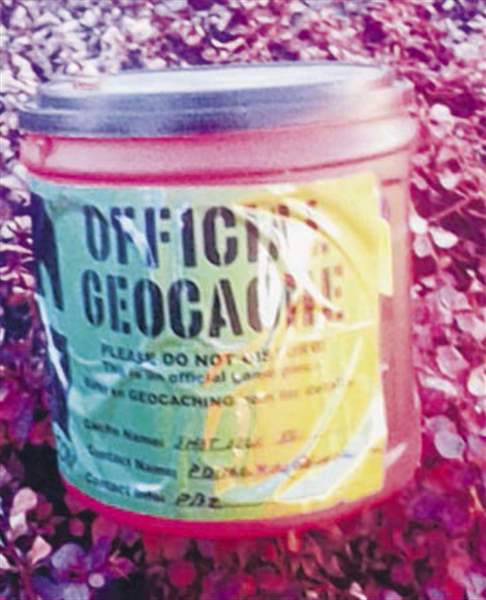
GEOCACHING
The hunt for fun is catching on
11/25/2012
A coffee can is marked as a geocache and hidden under bushes.

A coffee can is marked as a geocache and hidden under bushes.
Think of geocaching as high-tech hide-and-seek.
Instead of looking for your playmate behind the garage or in a tree, you’re using coordinates of a geographical location to hunt for cache — things like a magnetic matchstick attached to a lamp post, a pill bottle off the side of the road, or a stone with a special carving in a community garden — all strategically placed and waiting to be found.
Geocaching is one of the fastest growing outdoor activities, with clubs all over the country, including northwest Ohio. Using GPS technology, searchers look for cache, much like a scavenger hunt. Geocachers can find themselves anywhere from the depths of a thick woods to the streets of a downtown area.
“When I first started caching it felt like a wild-goose chase, going out in the middle of woods to find a box,” said James Engard, a geocacher from Leipsic in Putnam County. “It was during the winter that I realized caching in the woods was so peaceful.”
Through GPS or an app on a smart phone, enthusiasts can directly link to a network of caches in the area or other cachers. Apps and sites such as NWOGEO.org and geocaching.com allow participants to tally up their finds, search for new ones, and get hints.
Mr. Engard also serves as the representative for geocaching in the Hancock County Parks and is a member of the Grey Beards, a group of men 55 and older who hunt for cache across the region. With the help of some other cachers, the group started NWOGEO.org, where area participants post and log caches.
A typical cache is usually a small waterproof container with a logbook, where geocachers can put their name, the date, and any other information they wish to share about their experience. Often, stashers include a special gift for the first person to find it, usually coins or batteries for the GPS.
According to geocaching.com, there are almost 600 caches within 10 miles of downtown Toledo, including finds at Fifth Third Field and Toledo Edison.
Thousands are hidden in Metroparks across Lucas County. Stashers are required to apply for a geocaching permit to hide treasures on park grounds.
Hancock County Park District is in the process of implementing a similar permit system. The district hosts an Introduction to Geocaching event every spring.
“There are a lot of people that geocache in the area and it brings people out to the parks,” said Stacie Roby, Hancock County parks program manager. “It’s an outdoor recreational sport that gets people outdoors and active. We’re very supportive of it.”
Ms. Roby estimates that there are thousands of caches hidden in Hancock County parks, including many “Earth caches.”
“It’s not a box or item, but instead, a geology quiz about the area,” Ms. Roby said. “When you find the cache location, you get some history on the location.”
Geocaching began around 2000, and by 2010 there were more than 1 million caches hidden worldwide. Geocachers work at their own pace, making the sport suitable for just about anyone, including older adults and children. Most caches stay in place for several years, giving searchers plenty of time to find them.
Mr. Engard got his start about 10 years ago. His first year, he logged 300 finds, placing him in the top 25 cachers in Ohio for that year. Last month, he logged his 2,000th find. He sees the activity as a way to exercise and keep active.
“At the time when I started I was having heart problems and the doctor advised me to start walking more,” said Mr. Engard, 55. “At the time, most of the caches were in the woods or parks and generally a quarter-mile from parking lots, so doing one cache was about a half-mile round-trip.”
The Toledo-Lucas County Library got in on the fun in 2010, using geocaching as a way to draw visitors into the library by placing multiple caches in 18 of its branches.
“We were discussing ways to get people into the library and geocaching came to mind,” said Dave Misko, a computer network engineer at the library and recreational geocacher. “We wanted people to see that we’re more than just books. We’re programs too.”
Caches are logged through the library’s catalog system, making it the first library in the world to have geocaches on the shelves as catalogued items.
At the main library, hunters find their first cache outside, with instructions on how to find the second cache inside. Hunters will have to complete all six steps to find the treasure.
“Ultimately what it is, is a tour of the main library,” Mr. Misko said. “It’s a way to get people to visit the branches and even multiple branches.”
The library caches have been hidden for about two years, and are still found on a weekly basis, Mr. Misko said.
“On the sites you’ll see people posting ‘I’d never been to this library,’ and all sorts of compliments about the geocache, and compliments to the library in general. It worked.”
Contact RoNeisha Mullen at: rmullen@theblade.com or 419-724-6133.